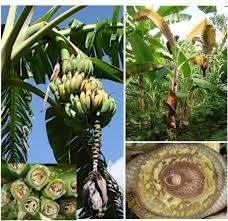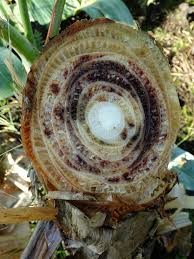Bananas
Pests and Diseases
6.0 Pests and diseases
Pests:
- The Burrowing Nematode: Damage the plants as they enter the roots and corms but also provide an entry point for root rot fungus.
- The banana weevil: Presence detected through black tunnels it makes in the corm. It is prevalent in old mats that are not properly weeded. It can be controlled by using clean materials and where there are severe cases the plants are to be replaced.
Pests Control:
- Planting clean banana suckers.
- Properly weeding plantations.
- Using resistant banana varieties.
- Where severe, replace banana plants.
 6.1. Diseases:
6.1. Diseases:
Black Sigatoka
- The disease infects the banana leaves and is known to start with black lines parallel to the leaf’s veins. With time they become longer and turn muddy brown.
- It is most severe during the rainy season and for severe cases, plants die.
- Controlled by restricting movement of the plants and burning of infected leaves.
Leaf spot
- Starts with small brown spots surrounded by a yellow color but as it progresses the spots start to merge and cover a larger surface area of the leaf.
- In severe cases it makes the fruit ripen prematurely.
- Control measures are the same as those of Black Sigatoka.
 Fusarium Wilt
Fusarium Wilt
- A disease caused by a soil borne fungus. It attacks the rhizome first and progresses to the pseudostem.
- It blocks the vessels of the vascular system disrupting the process of water movement through the plant.
- When the pseudostem of the infected plant is cut there is a purple discoloration of the vascular bundles.
- This disease is common to Magombo and Zambia varieties.
- The disease cannot necessarily be controlled or cured. There is the option of soil treatments which is harmful to the environment.
- Fusarium wilt is most severe in poorly drained soils.
Anthracnose
- Causes black circular spots on the peel of the mature fruits. Eventually the infected fruits rot.
- Controlled by collecting and burning infected material.
- Uninfected harvested mature plants should be stored in hygienic storage place.
- Minimize bruising during transportation.
Cigar-end rot
- Characterized by blackening of fingers and in severe cases it spreads throughout the whole fruit which becomes blackened.
- Controlled by removing petals from the tips of fingers and removing flowers after fingers are well formed.
Armillary root rot
- Identified by rotting of the corm and the presence of white fungus.
- Controlled by ring barking unwanted trees 2 years prior to establishing the plantation, leaving them to die and then uprooting them.
Banana Bunchy top virus
- It affects all banana varieties.
- It is spread where there is movement of affected planting material.
- It is characterized by stunted plants with narrow leaves that are upright, pointed and brittle.
- The mother plants produce an abnormal number of suckers that look clean but are in fact infected.
- It can be controlled by using clean planting materials and restricting movement of these planting materials.
- In the most extreme cases uproot and get rid of all infected plants.
